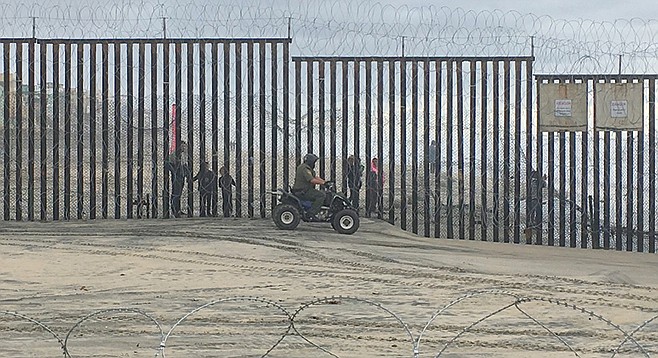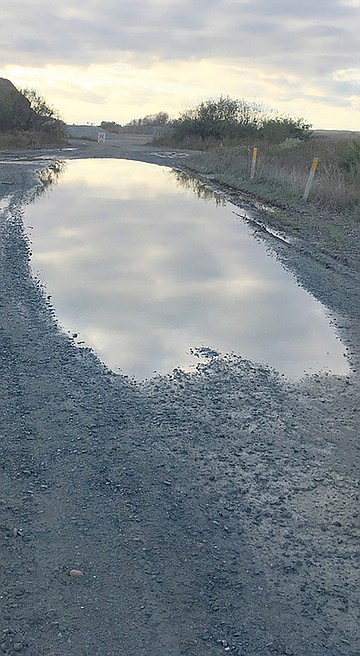 Facebook
Facebook
 X
X
 Instagram
Instagram
 TikTok
TikTok
 Youtube
Youtube

“If I had known the walk was what the walk was, I would have stayed in the car,” says the man at the beach where the United States ends and Mexico begins. And it was a walk, maybe a mile and a half past the entrance to Border Field State Park, past the paper sign taped to the big metal one warning that the park is closed to vehicles. (The paper sign reads, “Friendship Circle will be closed until further notice,” referring to the beachside break in the buffer zone between the rust-brown border wall and the taller, tougher stateside version: Friendship Circle & Bi-National Garden, open four hours a week, maximum occupancy 10, area under 24-hour surveillance, no filming or recording, caution: enter at your own risk.) Beyond the paper sign, a yellow diamond warns that the path is subject to flooding, and that “contact with this water may cause illness: bacteria levels exceed health standards.” At one point, the intrepid hiker must traverse a makeshift walkway — square posts, two-by-fours, rocks, and a patch of plastic fencing that sinks underfoot into the sloshing, fetid puddle it spans — on his journey to, as the man’s companion puts it, “see the end of the wall.”

He made it: the end is here, extending itself far out into the spumey surf, though the concertina wire lining the top stops at the waterline. The nearer wall ends where the beach begins. From there, rusted eight-foot chain link fence stretches maybe another 50 feet; two of the last sections lack top and middle support bars. More concertina wire weaves into the last section, and then runs in snaky figure eights behind the short iron posts strung with yellow caution tape out toward the water, stopping short of the spot where the tide might carry it away. “Doesn’t look like much, does it?” asks the fellow in the 5.11 tactical T-shirt. It doesn’t, but it doesn’t need to: when a man on the other side gets too close to the water, a border officer leaves his hilltop post and runs his ATV down onto the beach to corral the man back to his fellows.

His fellows are why we’re really here, of course. The wall is being tested by the migrant caravan — people whose walk to the wall was considerably longer and more fraught than ours — and barriers are generally weakest at their edges. The ATV chugs back into view when four young black men approach. When I ask one of them why he came, he replies, “Just seeing the sights in San Diego.” The camera-on-a-stick he plants in the sand, pointing at the people on the other side — mostly women and children, pressing themselves between the steel staves and waving — says otherwise: he’s here to witness something.
I feel rotten being here. I feel like a tourist of suffering. (The beach was empty when I arrived, but my presence was enough to bring a group to the fence, descending from a larger crowd in the park above.) We regard each other. They call out, but I don’t speak their language, and even if I did, I couldn’t hear them over the distance and the surf. All I can do is look at them and wave stupidly.
On the long walk back to my car, it’s hard not to start assigning significances to things: the migrant children, stopped in their tracks and playing chicken with the surf, a back and forth game that could go on forever. The shorebirds perched atop the wall, indifferent to boundaries. The single orange poppy — California’s flower! — pushing up through the brown ground cover beside a discarded plastic bag. The great hush that falls after the four huge helicopters cease their endless circling and come to rest. The city, seen across an endless stretch of empty flatness, making a jagged patch of promise on the horizon.


“If I had known the walk was what the walk was, I would have stayed in the car,” says the man at the beach where the United States ends and Mexico begins. And it was a walk, maybe a mile and a half past the entrance to Border Field State Park, past the paper sign taped to the big metal one warning that the park is closed to vehicles. (The paper sign reads, “Friendship Circle will be closed until further notice,” referring to the beachside break in the buffer zone between the rust-brown border wall and the taller, tougher stateside version: Friendship Circle & Bi-National Garden, open four hours a week, maximum occupancy 10, area under 24-hour surveillance, no filming or recording, caution: enter at your own risk.) Beyond the paper sign, a yellow diamond warns that the path is subject to flooding, and that “contact with this water may cause illness: bacteria levels exceed health standards.” At one point, the intrepid hiker must traverse a makeshift walkway — square posts, two-by-fours, rocks, and a patch of plastic fencing that sinks underfoot into the sloshing, fetid puddle it spans — on his journey to, as the man’s companion puts it, “see the end of the wall.”

He made it: the end is here, extending itself far out into the spumey surf, though the concertina wire lining the top stops at the waterline. The nearer wall ends where the beach begins. From there, rusted eight-foot chain link fence stretches maybe another 50 feet; two of the last sections lack top and middle support bars. More concertina wire weaves into the last section, and then runs in snaky figure eights behind the short iron posts strung with yellow caution tape out toward the water, stopping short of the spot where the tide might carry it away. “Doesn’t look like much, does it?” asks the fellow in the 5.11 tactical T-shirt. It doesn’t, but it doesn’t need to: when a man on the other side gets too close to the water, a border officer leaves his hilltop post and runs his ATV down onto the beach to corral the man back to his fellows.

His fellows are why we’re really here, of course. The wall is being tested by the migrant caravan — people whose walk to the wall was considerably longer and more fraught than ours — and barriers are generally weakest at their edges. The ATV chugs back into view when four young black men approach. When I ask one of them why he came, he replies, “Just seeing the sights in San Diego.” The camera-on-a-stick he plants in the sand, pointing at the people on the other side — mostly women and children, pressing themselves between the steel staves and waving — says otherwise: he’s here to witness something.
I feel rotten being here. I feel like a tourist of suffering. (The beach was empty when I arrived, but my presence was enough to bring a group to the fence, descending from a larger crowd in the park above.) We regard each other. They call out, but I don’t speak their language, and even if I did, I couldn’t hear them over the distance and the surf. All I can do is look at them and wave stupidly.
On the long walk back to my car, it’s hard not to start assigning significances to things: the migrant children, stopped in their tracks and playing chicken with the surf, a back and forth game that could go on forever. The shorebirds perched atop the wall, indifferent to boundaries. The single orange poppy — California’s flower! — pushing up through the brown ground cover beside a discarded plastic bag. The great hush that falls after the four huge helicopters cease their endless circling and come to rest. The city, seen across an endless stretch of empty flatness, making a jagged patch of promise on the horizon.
Comments